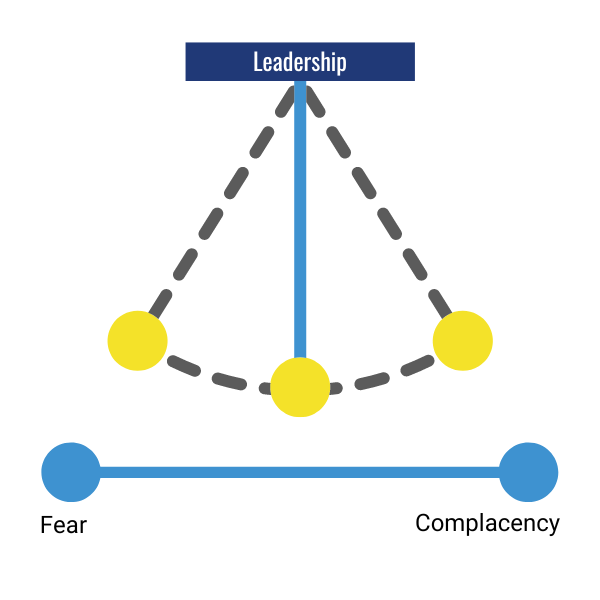Avoiding Past Ruminations and Future Worries.
Business leaders today face a particular challenge; the need to stay ahead of the competition and mitigate for risks, while also not getting bogged down in worrying about what might happen in the future. To achieve a balance between the two, leaders must learn to embrace and lead in the present. By doing so, they can open themselves up to the opportunities of living in the here and now, and avoid the dangers of always playing it safe. In this article, we discuss the importance of leading in the present and how to achieve it.
The importance of remaining in the here and now.
In today’s fast-paced business world, it is easy to get caught up in the chaos and constantly worry about what could go wrong in the future. While it is essential for business leaders to be proactive and take necessary steps to mitigate risk, it is equally important to remain present in the here and now.
One way to achieve this is by understanding the circle of control and the circle of influence. The circle of control consists of things that are within our control, such as our thoughts and actions. The circle of influence, on the other hand, consists of things that we can influence but cannot control, such as market trends or the actions of our competitors. By focusing on what we can control, we can maintain a sense of calm and serenity, even in the face of uncertainty.
Being present in the here and now also requires us to be resourceful emotionally and in terms of activity in a phenomenological way. This means that we need to be aware of our emotions and the impact they have on our decision-making processes. It also means being open to new ideas and opportunities, even if they may seem risky.
Of course, it is important to strike a balance between risk mitigation and taking advantage of opportunities. While catastrophising is an important process for creating resilience plans, we also don’t want to be continually in a state of anxiety about what might happen.
Achieving balanced leadership means understanding that there is always an element of risk in any decision we make, but it is possible to manage that risk and make informed decisions that benefit our business. By remaining present in the here and now, we can tap into our resilience and stoicism, enabling us to navigate uncertain times with confidence, and inspire that confidence in others.
Being aware of the environment you’re working in.
As a business leader, you are likely to operate in a highly competitive environment, where you are expected to deliver results and achieve success at all costs. This pressure can cause you to lose sight of the present moment. You may become too focused on future goals, worrying about the what-ifs, and the impact that this could have on your business.
One useful way to manage this stress is to take a lesson from the military. In the military, stress testing is a common practice. It involves subjecting soldiers to a series of intense and high-pressure situations that help to prepare them for future crisis situations. This kind of training helps soldiers to remain calm and focused in the moment, even when faced with high-stress situations.
Similarly, as a business leader, it’s important to remain aware of the environment you’re working in and understand how it can affect your decisions. It’s important to acknowledge the stress and pressure that come with leading in a competitive environment. It’s equally important to learn how to manage these stressors effectively and develop strategies that help you stay focused in the present.
One approach that can be useful is mindfulness. Mindfulness is the practice of being present in the moment and not getting caught up in thoughts or feelings about the past or future. By learning to be mindful, you can better focus on the task at hand, stay present in the moment, and avoid becoming distracted by concerns about the future.
Another way to remain aware of your environment is to pay attention to the people and the culture around you. Get to know your colleagues, your clients, and your competitors. Understand what motivates them and what drives their decision-making processes. By understanding these factors, you can make more informed decisions and be better prepared to handle challenges as they arise.
What you can do when you’re stuck in the moment.
Being present is an important quality for any business leader, but what happens when you feel like you’re stuck in the moment? It’s easy to get lost in the day-to-day challenges of running a business, but it’s essential to take a step back and evaluate your current situation.
One way to do this is by asking yourself these questions:
- What is the crux of this problem?
- On a scale of 1- 10, how bad is this problem? What will actually happen if I don’t fix it?
- In six months’ time, what will it look like?
- What resources do I have available right now in terms of time/budget/people?
- What are my actual constraints/barriers vs those that I am making assumptions about?
- Whose expertise can I utilise? What ideas might others in my team have?
Who becomes the judge of what is considered acceptable risk?
It’s worth remembering that what may seem like an acceptable risk to you, may not be the same for others in your organisation or even for your customers and stakeholders. When making decisions about risk, it is important to consider the potential impact on all parties involved. This includes evaluating the potential benefits and drawbacks, as well as the likelihood of success or failure.
Risk is subjective and can vary depending on many factors, such as market conditions, financial stability, and company culture. Finding a balance between complete risk avoidance and taking calculated risks is a delicate process that requires constant evaluation and adjustment.
As a leader, you can establish clear guidelines and protocols for evaluating and managing risk. This can include regular risk assessments, training and education for employees, and implementing effective communication strategies to ensure everyone is on the same page.
Remember, being too cautious can limit your organisation’s potential for growth and innovation. On the other hand, taking too many risks without proper consideration and planning can have devastating consequences. Finding the right balance requires a thoughtful and proactive approach to risk management.
The importance of having a balance between the past and the future.
Business leaders are often caught up in worrying about the future or analysing past decisions, which can lead to missed opportunities in the present. On one hand, looking to the future is essential for anticipating changes in the industry, developing innovative ideas, and setting goals. However, excessive worry about what might happen in the future can be paralysing.
Dwelling too much on past mistakes or successes can be equally limiting. While it’s important to learn from past decisions, being overly preoccupied with them can keep leaders from seeing new opportunities or taking chances. The past is important to inform decisions, but it shouldn’t dictate them.
Achieving a balance between the past and future requires an awareness of the present moment.
Ultimately, it’s crucial to find a balance between mitigating for risk and living in the present moment. Business leaders must keep an eye on the future without worrying too much about it, while also learning from the past without letting it control the present. When they strike the right balance, leaders can make confident decisions that help their organizations thrive.
Achieving the ideal overall balance
Ultimately, if you think of risk as a continuum from paralysing fear to complacency, the arc of the pendulum swing and its centre of gravity will depend on circumstances, a person’s natural phenomenological experience; and where they naturally tend to fall on that continuum. Achieving a balance is about reducing extremes, while still retaining the flexibility to react with creativity to challenges as they arise.


